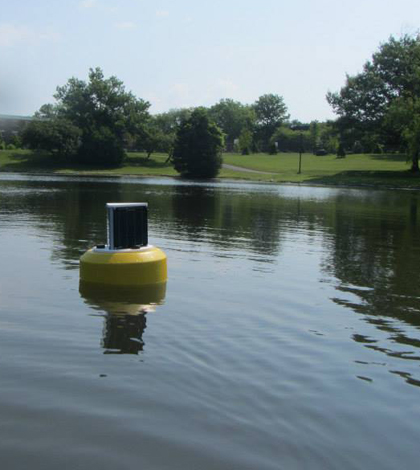Monitoring ‘The Gunk’: Buoy tracks New Paltz campus pond water quality

A data buoy floats on 'The Gunk' on the SUNY New Paltz campus
The Shawangunk Mountains–known locally as “The Gunks”–lend a scenic geological backdrop to the State University of New York at New Paltz. They also lend their name to a pond on campus that students and staff call “The Gunk.”
While the name’s origin may lie in the mountain range, the pond’s appearance might have helped helped it stick.
“It’s definitely gunky,” said Alex Letourneau, a New Paltz senior studying computer science. “I wouldn’t recommend swimming in it. I know people who have, but I’m not that brave.”
Aesthetics aside, the pond has become a focal point for a water quality monitoring effort across campus. A monitoring buoy floating on the Gunk is part of a project to collect baseline data on the water passing through the pond before it eventually ends up in Saw Mill Brook, which flows into the Wallkill River, a tributary of the Hudson River.
The monitoring is backed by a collaboration between New Paltz, the New York Department of Environmental Conservation, the New York State Water Resources Institute at Cornell University and the Hudson River Estuary Fund. They’re also supporting an initiative to outfit the campus with more green infrastructure like rain gardens, bioswales and permeable pavement. The data will help show whether those installations are benefiting water quality. Another aspect of the project will build elements of the monitoring and the infrastructure into education and outreach tools.
Though David Richardson, assistant professor of biology at New Paltz, is overseeing the monitoring, he said students are playing an important role in the investigation. This level of participation by undergraduate students is relatively rare, he said.
“There are a few exceptions, but most of the other people are working with graduate students or professionals or government agencies,” Richardson said. “I think this is a pretty cool project because it involves mainly undergraduates that are driving the research.”

Letourneau, the senior studying computer science, is one of those students. Having taken a few biology classes and developed an interest in the field, he approached Richardson about working on a project that would combine with biology his major.
Before long, Letourneau was tasked with assembling and deploying a NexSens MB-100 buoy equipped with a YSI EXO 2 multiparameter water quality sonde measuring pH, temperature, conductivity, dissolved oxygen and turbidity.
“I was kind of diving in blind,” Letourneau said. “It was pretty scary from my end of things. I was basically told I get to just figure out this really expensive, high-end piece of technology, and get it working for a purpose that I’m not the most familiar with.”
Despite those initial misgivings, he got the buoy up and running. Though data collection began in June, it has already given researchers an idea of what’s going on in the Gunk. For example, the data showed how the pond responded to June’s wet weather.
“Conductivity went way down because there was dilution,” Richardson said. “But turbidity went up because it was stirring up and eroding away some of the sediment. It was interesting to see that storms are positive in some impacts and perhaps negative in others.”

In addition to getting the monitoring hardware going, Letourneau designed and developed the website that displays buoy data in near real-time. The design is clean and intuitive, which he and Richardson say should help in its outreach and education role for non-experts.
“You have to make a website appealing to someone who’s not necessarily too familiar with, or maybe even interested in, science,” Letourneau said. “You have to catch their attention a little bit and make it easy for them to take it all in and learn from it.”
Top image: A data buoy floats on ‘The Gunk’ on the SUNY New Paltz campus




0 comments